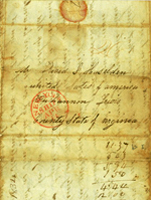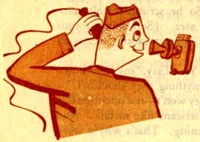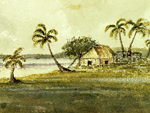Roosevelt Island
Greg Young and Tom Meyers describe the history of New York's Roosevelt Island, which once housed many of the city's prisons, mental institutions, and hospitals.
Greg Young and Tom Meyers describe the history of New York's Roosevelt Island, which once housed many of the city's prisons, mental institutions, and hospitals.
From the BackStory website:
"Historian Cindy Aron discusses the origins of the modern American vacation. She explains why traveling to the beach didn't used to be appealing, and why Americans have often preferred 'self improvement' vacations to lazing around in a hammock."
From the BackStory website:
"Historian James Morone explains what nativism, racism, and women's suffrage had to do with the temperance movement of the early 20th century. And he argues that Prohibition was not the abysmal failure it's often made out to be.'"

Founded in 1816, the American Colonization Society (ACS) advocated sending manumitted slaves and free blacks living in the United States to Africa. The first "repatriated" black emigrants landed in Liberia in 1821. They were not prepared to till the land and the local, displaced Africans were hostile. Most importantly, the American-born blacks were highly susceptible to malaria and yellow fever.
This website offers the opinions of surviving pioneers, including six compelling letters authored in 1834 and 1835 by Samson Ceasar, a freed slave, who wrote to David Haselden and Henry Westfall of Buchannon, VA. An additional 44 letters were sent by former slaves of James Hunter Terrell to Terrell's executor, Dr. James Minor, between 1857 and 1866. The diverse letters not only reflect the complex bonds between former slaves and masters, but underscore the persistently unequal relationship.
NBC's Ann Curry interviews the author of Gettysburg: A Testing of Courage about the strategies and the combat at the Battle of Gettysburg.

Where did the line in FDR’s First Inaugural Address, “The only thing we have to fear is fear itself,” come from? Did he write it?
Columbia University professor Raymond Moly wrote most of Roosevelt’s speech, and talked over his initial drafts with the president-elect. Several days before the inauguration, Moly delivered a typescript of his final draft to Roosevelt, who was staying at the Mayflower Hotel in Washington, D.C. Roosevelt went over the speech then with Moly and copied it out in longhand. The line about “fear itself” was not in the speech at that point. Before leaving FDR’s hotel suite, Moly burned his typewritten draft in the fireplace.
The next day, former newspaperman and Roosevelt’s long-time close confidante, Louis McHenry Howe, arrived in Washington. According to Howe’s assistant Lela Stiles, a few days previously, Howe had talked with a newspaperman and friend about difficulties that the country faced, and during the conversation Howe told his friend, “I don’t care what else Franklin says in his inaugural address as long as he tells the people that the only thing they have to fear is fear.”
When Howe arrived in Washington, FDR gave him his handwritten draft of the speech. Howe made his own changes and additions and had a secretary type a new draft. One of Howe’s changes had been to add the line, “So first of all let me assert my firm belief that the only thing we have to fear is fear itselfnameless, unreasoning, unjustified terror which paralyzes the needed effort to bring about prosperity once again.” FDR liked Howe’s addition, but then, on the draft, changed the end of the sentence, from “to bring about prosperity once again” to “needed efforts to convert retreat into advance.” These were the words he used when he delivered the speech several days later at the inauguration, on March 4, 1933.
Roosevelt’s revision of Howe’s sentence was in keeping with the revisions that he and Moly had made to earlier drafts. One of the guiding metaphors in the first versions of the speech had turned on comparing the country’s economic condition to a sickness, but Moly had ultimately decided that Roosevelt would be better able to inspire the nation to profound and wide-ranging action if he did not compare it to an invalid, but rather to an army preparing for war. The imagery of sickness in the early drafts yielded therefore to martial language in the last drafts. FDR’s change of Howe’s sentence followed along with this.
Nevertheless, the new version of the sentence still refers to fear and a rejection of being "paralyzed." Whatever else FDR conveyed to his listeners with this sentence, a message of reassurance about his own health was surely part of what they heard. Concerns about whether his polio had incapacitated him had sometimes surfaced during the election campaign and two weeks before the inauguration he had avoided the bullets of a would-be assassin.
Frances Perkins, who served as FDR’s Secretary of Labor, reminisced in 1946, more than a decade after the speech, about Roosevelt coming to terms with his having contracted polio in 1921. She wrote, “He learned in that period and began to express firm belief that the ‘only thing to fear is fear itself.’ He never displayed the slightest bitterness over his misfortune.” Perkins was a little unclear here about whether she was referring specifically to Roosevelt in the decade before he became president, and whether she really meant to place the exact phrase “the only thing to fear is fear itself” in his mouth during that time.
If Roosevelt had in fact often expressed those words, it is difficult to understand why his closest colleagues and even his wife Eleanor did not assume that he had thought them up himself and inserted them into the inaugural address, but looked elsewhere for the ultimate source of the expression. When FDR’s associate and sometimes-speechwriter Samuel Rosenman asked Eleanor about the expression, she ventured that her husband may have found something very much like it in a volume of Henry David Thoreau’s writings, which she thought he must have had with him in his hotel suite in Washington.
Thoreau had written the sentence, “Nothing is so much to be feared as fear,” in his journal entry for September 7, 1851, in passing, as part of his comment on his contemporaries’ criticisms of Harriet Martineau’s arguments for atheism in her just-published Letters on the Laws of Man’s Nature and Development. Ralph Waldo Emerson later quoted his young friend approvingly, and the phrase was indeed included in later collections of Thoreau’s writings.
Professor Moly, however, pointed directly at Louis Howe as the proximate source, and doubted that Howewhose reading habits focused on detective novelshad found the Thoreau quote. He later told William Safire, “I do clearly remember that the phrase appeared in a department store’s newspaper advertisement some time earlier in February. I assume that Howe, an inveterate newspaper reader, saw it too. …" To Howe’s everlasting credit, he realized that the expression fully fitted the occasion.”
Moly's reference to department store advertisements sounds like the campaign used by Wanamaker’s. During the first few months of 1933, Wanamaker’s department store placed large display ads in The New York Times. The ads included a small box with inspirational messages of business and commercial platitudes or sentiments “from the founder’s writings,” those of John Wanamaker, who sometimes quoted people like Benjamin Franklin or George Washington. I do not see any of ads for the first two months of 1933 in which Wanamaker quoted Thoreau or anyone else expressing precisely the statement about “fear itself,” nor do I see a quote of Wanamaker venturing the phrase himself. However there are many platitudes there about confidence, cheerfulness, a positive attitude, persistence, honesty, and integrity. Perhaps Professor Moly saw an ad that I have been unable to locate.
The phrase “The only thing to fear is fear” did have some currency at the time among businessmen. Julius Barnes, the Chairman of the Board of the National Chamber of Commerce, for example, gave a news conference in early February announcing the organization’s effort to promote efforts to stabilize business suffering during the depression. The conference was reported by The New York Times on February 9. One of the subheadings of the article was “Fears Most Fear Itself,” and quoted Barnes as saying, “In a condition of this kind, the thing to be feared most is fear itself. Confidence, tempered with prudence, is necessary to the operation of even the most perfect business mechanism. The retarding effect of a sense of insecurity is promptly communicated from worker to consumer, from consumer to producer and the whole machine stalls, and the anticipated evil becomes.”
Many in the business community were in fact convinced that the country was suffering from a kind of psychic sickness, caused not by systemic problems in industry or banking, but by the nation’s irrational lapse into fear, which had caused an economic paralysis. It was the fear itself that needed to be exorcised. FDR’s predecessor, Herbert Hoover, also often spoke in this way.
By this metaphor, the nation was an invalid who had been afflicted with a mental problem, a paralysis of action. Its thinking somehow had to be turned around, toward a positive confidence. By changing the patient’s thinking, his body would naturally recover his mobility. The nation needed a mental healer.
This sounds rather like the frame of reference of the quasi-religious “New Thought” or “Mind-Cure” or “Mental Science” Movement that blossomed in the United States in the late 19th and early 20th centuries. As William James described it in his 1929 work, The Varieties of Religious Experience, “The leaders of this faith have had an intuitive belief in the all-saving power of healthy-minded attitudes as such, in the conquering efficacy of courage, hope, and trust, and a correlative contempt for doubt, fear, worry, and all nervously precautionary states of mind.” The movement was defined not so much by an organizational form as by the common assumptions and themes of a group of writers who specialties included what we would today called “alternative medicine,” speculative psychology, and inspirational literature. Their writings are dominated by perorations on healing and success. The business community, then as now, had a fondness for “motivational” speaking and writing, especially as it might make a sales force more effective. It is likely not an accident, therefore, that the head of the Chamber of Commerce would be diagnosing the chief of the nation’s problems as fear.
In fact, the precise phrase, “The only thing to fear is fear,” occurs in the 1908 book, Thought Vibration; or, the law of attraction in the thought world, written by New Thought writer William Walker Atkinson. He counseled, “Remember, the only thing to fear is Fear, andwell, don’t even fear Fear, for he’s a cowardly chap at the best, who will run if you show a brave front.” In 1918, Atkinson wrote The Power of Concentration under the pseudonym of Theron Q. Dumont, in which he declared, “There is no justification for the loss of courage. The evils by which you will almost certainly be overwhelmed without it are far greater than those which courage will help you to meet and overcome. Right, then, must be the moralist who says that the only thing to fear is fear.”
Another “New Thought” writer, the “naturopathic doctor,” Henry Lindlahr, wrote in his 1919 book, Practice of Natural Therapeutics, “Avoid fear in all its forms of expression; it is responsible for the greater part of human suffering. The only thing to fear is fear.”
Businesses had invoked these precise sentiments around the time they were published, during the domestic economic pinch prevalent during World War I, for example. On the 4th of July, 1917, the musical instrument firm of Edward Droop and Sons in Washington, D.C., paid for a large display ad in The Washington Post, under the large headline, “The Only Thing to Fear Is Fear.” The firm’s ad continued:
We refuse to be perturbed by the alarmists, the pessimists and by the timid who see things at night. As prophets in the past they have a batting average of about .001. The only times they have hit the truth is when they themselves created the conditions they feared by fearing them. Our slogan during these earnest times is “Keep Business Going.” We shall retrench in nothing, cancel nothing, fear nothing. Our faith in the existing and eternal prosperity of the United States of America is immovable. … We believe that this is the very time of all times that you should buy what you wantwhether it be in our line or in any other. The only way to stop your business is to stop the other fellow’s. The only thing to fear is fear.
The phrase “The only thing to fear is fear” and its variants, therefore, were demonstrably “out there” in circulation within the business community during the first few decades of the 20th century. William Safire makes the point that it does not really matter where the phrase came from because it was FDR that used it during his speech to inspire the nation and it was he, therefore, who transmuted the linguistic coin into rhetorical gold.
Text and audio of FDR's First Inaugural Address, March 4, 1933, at History Matters.
William Walker Atkinson, Thought Vibration: or, The law of attraction in the thought world, Chicago: The Library Shelf, 1908, pp. 46-49.
“Business to Make Stabilization Study: National Commerce Chamber Is Forming Committee to Work Out Formal Program,” New York Times, February 9, 1931, p. 3.
Theron Q. Dumont (William Walker Atkinson), The Power of Concentration. Chicago: Advanced Thought Publishing Company, 1918.
Davis W. Houck, FDR and Fear Itself: The First Inaugural Address. College Station: Texas A&M University Press, 2002, pp. 119-120.
William James, The Varieties of Religious Experience. New York: 1929, p. 93.
Henry Lindlahr, Practice of Natural Therapeutics. Chicago: The Lindlahr publishing company, 1919, p. 447.
“The Only Thing to Fear Is Fear,” Display ad for E. F. Droop & Sons, Company, Washington Post, July 4, 1917, p. 2.
Frances Perkins, The Roosevelt I Knew. New York: Viking Press, 1946, p. 29.
William Safire, “Nothing to fear but fear itself,” Safire’s Political Dictionary, rev. edition. Oxford: University Press, 2008, pp. 481-483.
Lela Stiles, The Man Behind Roosevelt: The Story of Louis McHenry Howe. New York: The World Publishing Company, 1954, p. 235.
“The Value of a Silver Tongue,” Bankers’ Magazine (May 1927): 666.

A 28-page study, including charts, of 1960 census data compiled according to residence areas, or "tracts," within the cities of Atlanta, Baltimore, Chicago, Cleveland, Detroit, Newark, New Orleans, Philadelphia, and Pittsburgh. Also provides census data for 1940 and 1950 with regard to Chicago and Detroit. Offers raw data and percentage computations on total population of tracts, number of males and females, African-American ethnicity, foreign origin, age, marital status, income level, education, units of substandard housing, rent amounts, employment figures, and salary levels. Also provides medical-related data, such as numbers of hospitals, hospital beds, pharmacists, and types of physicians in each tract. Of use for those studying mid-20th-century urban history. See "History Matters" entry Data and Program Library Service: Online Data Archive for information on other social science studies available at this site.

Especially since the 1950s, civil rights litigation has done much to influence government institutions. This website presents at least partial information on 2,243 injunctive civil rights cases (those seeking policy change and not money). These cases are divided by category. "Jail Conditions" and "Prison Conditions" contain the most cases, with roughly 550 each. "Immigration" and "Juvenile Institutions" also include more than 150 each. Other categories include: "Mental Health Institutions," "Mental Retardation Institutions," "Child Welfare," "Nursing Home Cases," "Policing Cases," "Public Housing," "Equal Employment," and "School Desegregation," among others.
A good place to begin is the "Featured Cases" section on the website's homepage, which highlights cases from the collection that are being litigated currently and/or that are particularly relevant to current events. Cases are fully searchable by name, type, issue, district, circuit, state, causes of action, attorney organization, and people involved in the case. In addition, links to 141 case studies written by law students, professors, journalists, and policy advocates provide in-depth information on a specific case or issue, such as the Urban Institute's "Baseline Assessment of Public Housing Desegregation Cases." New material is added regularly.

More than 300 U.S. government publications from World War II have been digitized for this site, an ongoing project that plans to add another 200 documents.
Materials include pamphlets and books emphasizing home front issues, such as air raids, preservation, child labor, and victory farms. All materials are searchable by title, author, subject, and keyword. Browsing is also available.
A companion collection of photographs, the "Melvin C. Shaffer Collection," depicts the home front situation in Germany, North Africa, Italy, and Southern France from 1943 to 1945. Shaffer was a U.S. Army medical photographer assigned to document the medical history of the war through major campaigns. Shafer took the photographs on this site—totaling approximately 340—unofficially with the goal of recording the war's impact on civilians.

Don't let Guam be forgotten in your classroom! After all, it is one of only 16 non-self-governing territories worldwide that are recognized by the UN. As such, leaving Guam out of history is to ignore a rather remarkable political exception.
Guampedia offers a range of short articles on everything from architecture to World War II. These pages also feature relevant photographs and further resource listings. Additional sections offer basic facts on Guam (motto, population, etc.) and its major villages. Be sure to check out the history lesson plans to see if there's any ready-made content appropriate for you to introduce to your classroom.
Additional ways to explore include a selection of media collections including photographs, illustrations, soundbites, and video; MARC Publications, including issues of the Guam Recorder, lectures, and additional e-publications on topics such as archaeology and stonework; and traditional recipes.